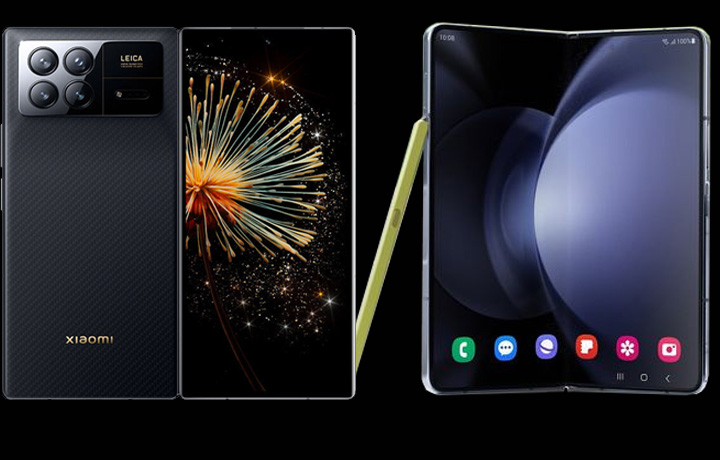Samsung Galaxy Z Fold 5 vs. Xiaomi Mix Fold 3: A Comprehensive Comparison
The smartphone market is continually evolving, with new innovations and advancements introduced regularly. One such innovation is the concept of foldable smartphones. In this comparison, we will delve into two notable contenders in the foldable smartphone market: the Samsung Galaxy Z Fold 5 and the Xiaomi Mix Fold 3.
Both devices offer unique features and capabilities, and we will explore their differences in design and build quality, display quality, audio performance, software experience, chipset and hardware, battery life, camera capabilities, and finally, we will provide a conclusion on which device may be the better choice for potential buyers.
Design and Build Quality
Both the Samsung Galaxy Z Fold 5 and Xiaomi Mix Fold 3 share a common design philosophy – a foldable smartphone that unfolds into a mini tablet. However, there are key differences in their design and build quality.
The Galaxy Z Fold 5 boasts a revamped hinge that allows it to fold completely flat with no gap, enhancing its elegance and usability. Samsung has made significant improvements over its predecessors in terms of design.
In contrast, the Xiaomi Mix Fold 3 also folds flat but is notably slimmer than the Galaxy Z Fold 5. It features an interesting textured back that resembles leather but is actually made of glass. However, a drawback of the Mix Fold 3 is the absence of official Ingress Protection (IP) ratings for water resistance, whereas the Galaxy Z Fold 5 is rated at IP68.
Display Quality
The display is a critical aspect of foldable smartphones, and both devices offer unique features in this regard.
The Xiaomi Mix Fold 3 comes with an outer AMOLED screen that is larger than the Galaxy Z Fold 5, providing a more comfortable aspect ratio for holding the device. Furthermore, the Mix Fold 3 has a larger main display, offering a more immersive experience when unfolded.
While the two devices have similar maximum brightness levels and support HDR10+ video, the Mix Fold 3 distinguishes itself with Dolby Vision support. Notably, the Mix Fold 3’s crease, where the panel folds, is less pronounced than that of the Galaxy Z Fold 5, contributing to a more seamless viewing experience.
However, the Galaxy Z Fold 5 has an advantage with stylus support, enhancing productivity for users who prefer digital note-taking and drawing. This feature is notably absent in the Mix Fold 3.
- Oppo Find N2 Flip Review
- Discover the Ultimate iPhone 14 Accessories
- Compact Smartphones in 2023: A Roundup of Top Choices
Audio Performance
Audio quality is another critical factor when evaluating smartphones, and both devices offer stereo speakers.
Both the Galaxy Z Fold 5 and Mix Fold 3 have stereo speakers of approximately the same loudness. However, the Mix Fold 3 provides an edge in terms of clarity. The differences in audio quality can be better appreciated by listening to them directly, but it’s clear that the Mix Fold 3 offers a more refined sound experience.
Software Experience
Software plays a pivotal role in the user experience of any smartphone, and the Samsung Galaxy Z Fold 5 and Xiaomi Mix Fold 3 provide different software environments.
The Galaxy Z Fold 5 runs on Samsung’s One UI, which is optimized for foldable devices and offers a range of features tailored to the foldable form factor. In contrast, the Mix Fold 3 runs on the Chinese version of Xiaomi’s MIUI, which includes some foldable-specific features but also comes with pre-installed Chinese apps. Moreover, users of the Mix Fold 3 may find themselves missing out on Google services like Google Pay, Nearby Share, and Android Auto.
In terms of multitasking, both devices support split-screen apps and multiple floating windows. However, the Galaxy Z Fold 5 allows for up to three apps within split-screen simultaneously, offers horizontal split, and provides adjustable split ratios. Samsung also commits to extensive software support, promising four generations of OS upgrades and five years of security patches. Xiaomi’s support policy for the Mix Fold 3 remains uncertain.
Chipset & Hardware
The Samsung Galaxy Z Fold 5 and Xiaomi Mix Fold 3 are powered by the same chipset, the flagship Snapdragon 8 Gen 2. While both devices offer excellent performance, the Galaxy Z Fold 5 boasts a slightly higher CPU clock speed, resulting in slightly better performance in CPU-heavy benchmark tests.
However, it’s important to note that during prolonged stress tests, the Galaxy Z Fold 5 displayed some thermal throttling, while the Mix Fold 3 experienced more severe overheating issues, causing it to shut down. This raises concerns about the Mix Fold 3’s long-term performance and durability under heavy usage.
Battery Life and Charging Speed
Battery life is a critical consideration for smartphones, and the Mix Fold 3 outperforms the Galaxy Z Fold 5 in this aspect. The Mix Fold 3 achieved an impressive endurance rating of 117 hours when tested on its inner display, while the Galaxy Z Fold 5 scored 95 hours, which, although good, falls short in comparison.
When it comes to charging, the Mix Fold 3 supports 67-watt wired charging, and a charger is included in the box. In contrast, the Galaxy Z Fold 5 supports only 25-watt wired charging and does not come with a charger in the box. The Mix Fold 3 can charge from zero to seventy percent in half an hour, outpacing the Galaxy Z Fold 5’s charging speed.
Both devices support wireless charging, with the Mix Fold 3 offering faster wireless charging capabilities at 50 watts compared to the Galaxy Z Fold 5’s 15-watt wireless charging.
Main Cameras
The main camera setup is an essential aspect of any smartphone, and both the Galaxy Z Fold 5 and Mix Fold 3 offer capable camera systems.
The Galaxy Z Fold 5 features a 50-megapixel main camera, a 10-megapixel 3x telephoto camera, and a 12-megapixel ultra-wide camera. On the other hand, the Mix Fold 3 boasts a 50-megapixel main camera, a 10-megapixel 3.2x zoom camera, a 10-megapixel 5x zoom camera, and a 12-megapixel ultra-wide camera, giving it an additional zoom camera compared to the Galaxy Z Fold 5.
Main Camera Photo Quality
In terms of photo quality, there are distinct differences between the two devices. The Galaxy Z Fold 5 tends to produce more vibrant colors, while the Mix Fold 3 captures pictures with more detail and a natural-looking rendition. The dynamic range is also wider on the Mix Fold 3, making it a strong contender for photography enthusiasts.
After dark, the differences become more pronounced, with the Mix Fold 3 offering better low-light performance and improved detail capture.
Selfie Camera Quality
For selfie enthusiasts, both devices offer exceptional options. The best selfie results can be achieved by using the rear main camera and the cover screen as a viewfinder. Both devices excel in this regard.
However, if you prefer using the inner screen’s selfie camera, the Galaxy Z Fold 5 produces selfies with more vibrant colors and greater detail. In contrast, the under-display selfie camera on the Mix Fold 3 tends to produce blurry photos with reduced detail.
Main Camera Video Quality
Both the Galaxy Z Fold 5 and Mix Fold 3 can shoot 8K videos with their main cameras. Furthermore, their 4K video capabilities are impressive, with electronic stabilization ensuring smooth footage.
Conclusion
In the head-to-head comparison, the Xiaomi Mix Fold 3 emerges as the frontrunner, offering superior hardware, a slim design, expansive screens, impressive battery life, and rapid charging. However, its limited availability outside of China poses a significant drawback. Get your Xiaomi Mix Fold 3 here>>
The Samsung Galaxy Z Fold 5, on the other hand, excels in multitasking, waterproofing, and stylus support, appealing to a broader global audience. Ultimately, the choice between these two foldable devices hinges on individual priorities and accessibility to the Mix Fold 3.
As for alternatives, potential buyers might consider the Motorola Razr 40 Ultra or the Oppo Find N2 Flip, both of which offer unique features and design choices.
- Shop On Amazon Using Our Links To Support Us:
- Buy Samsung Galaxy Z Fold 5 – Get your Xiaomi Mix Fold 3 here>>
- Amazon best sellers – Amazon most gifted – Amazon under $25






